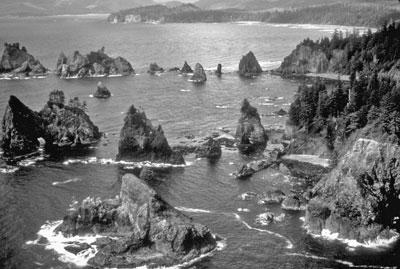Partner Profile: Olympic Coast National Marine Sanctuary—September 2003
At the edge of the world, just off the beaches of our North Coast region in one of the most rugged and pristine environments left along the West Coast, lies the Olympic Coast National Marine Sanctuary (OCNMS), a jewel in our environmental crown and a primary partner in COASST. OCNMS—in the capable persona of Mary Sue Brancato—has been with COASST from the beginning, reviewing early versions of Beached Birds, working with Program Coordinator Todd Hass to design the volunteer protocols, and performing as the COASST Volunteer Coordinator for participants in the Strait of Juan de Fuca and North Coast regions. Barbara Blackie and Katie Brenkman also play important roles in COASST, from staffing the ever popular Hobuck Beach site and training volunteers, to designing our special volunteer database (complete with photographs).
What’s so special about the Sanctuary? Plenty! In part because of its isolation and in part because of stewardship-minded landowners sharing its watery border (Olympic National Park, three National Wildlife Refuges, and four coastal Indian tribes—the Makah, Quileute, Hoh and Quinault), the Sanctuary includes some of the last remaining wilderness coastline in the lower 48 states.

A beautiful day at Point of Arches (OCNMS)
Encompassing 3,310 square miles from Cape Flattery to the mouth of the Copalis River, the Sanctuary includes most of the continental shelf and many types of marine habitat such as rocky intertidal zones, kelp beds and three deep submarine canyons like the Quinault that plunges to 4,528 feet within Sanctuary boundaries. Plankton-rich upwelling zones; rocky benches crammed with algae, mussels, and barnacles; and some of the State’s richest fisheries typify the area. OCNMS is home to 12 species of nesting seabirds, including Common Murres, Rhinoceros Auklets and Tufted Puffins; haul-outs for Harbor Seals and California and Steller Sea lions; shrimp-rich mud flats for hungry Gray Whale residents; and secluded nest sites for Peregrine Falcons.
Designated in 1994 as the first sanctuary in the Pacific Northwest, OCNMS protects our marine resources—both habitat and denizens—through a combination of research, education and resource protection. Aircraft must abide by a 2,000 foot ceiling, to minimize disturbance to marine mammals and nesting seabirds. Shipping traffic is directed to special lanes outside of the most sensitive regions of the Sanctuary, to help protect against the possibility of damaging oil spills. Active programs to map and monitor intertidal and subtidal habitats, follow Sea Otter populations, and count and identify (live!) seabirds are part of the research agenda of OCNMS. Volunteer programs provide an opportunity for citizens to get their feet “wet” and contribute to our knowledge of the Olympic Coast. But for many people, just knowing that the Sanctuary exists is enough.
If you have not had the opportunity to visit the Sanctuary we highly recommend it. Stop by the OCNMS office in Port Angeles (115 E. Railroad Ave., Suite 301) to meet Mary Sue and the staff and pick up a few tips about choice places to visit.